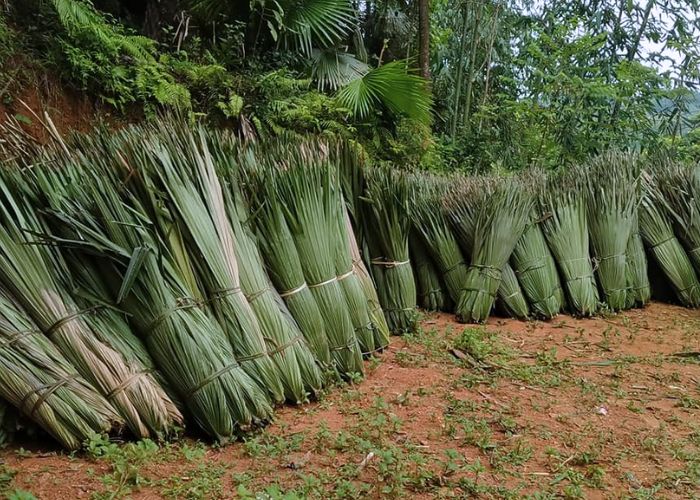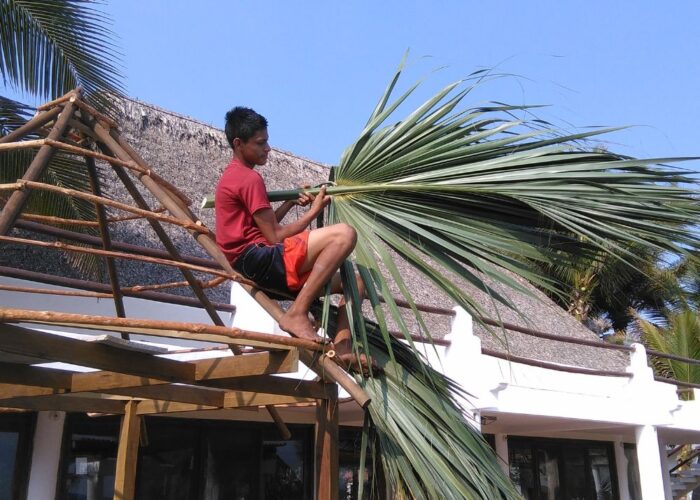In today’s context, exploring traditional building methods not only helps us connect with the past but also provides sustainable solutions for the future. One of the unique and environmentally friendly construction techniques is creating palm leaf roofs, a method that has been used for thousands of years.
This article will guide you through how to make thatch roof with palm fronds (palm leaves), from selecting the appropriate materials to detailed implementation steps, enabling you to create a cool and aesthetically pleasing roof while contributing to environmental protection.
1. How to make thatch roof with palm fronds?
Constructing a thatched roof with palm fronds is a traditional technique that can bring a tropical touch to any structure. To make a thatched roof with palm fronds, you’ll need the following materials:
Materials:
- Palm Fronds: Collect green palm leaves, preferably from a variety of palm tree that is readily available in your area. Ensure that the fronds are long and sturdy enough for thatching.
- Tools for Trimming: Sharp machete or knife for cutting and trimming the fronds.
- Pruning shears for finer trimming tasks.
- Framework Materials: Timber or bamboo poles for constructing the roof’s framework. These should be strong enough to support the weight of the thatch.
- Fastening Materials: Natural fibers such as twine or rattan strips for securing the palm fronds to the framework.
- Alternatively, you can use synthetic materials like nylon cord or zip ties.
- Optional: Thatching needle, Gloves, Ladder.
Step by step:
Step 1: Gathering palm fronds
Begin by collecting palm fronds. Choose green ones as they will dry out and cure over time, making them more durable for thatching.

Step 2: Trimming palm fronds
Trim the palm fronds carefully, removing any excess or damaged parts. Split the spine of each frond to increase flexibility.
Step 3: Framing the roof
Construct a sturdy framework for the roof. This frame will provide the support onto which the fronds will be attached.
Step 4: Layering the fronds
A sturdy framework for the roof is then constructed, providing a solid base for attaching the fronds. Start layering the palm fronds from the bottom of the roof, overlapping each row slightly to ensure water runoff. This layering technique helps create a tight and waterproof roof.

The fronds are securely attached to the framework using either natural or synthetic twine, woven in a pattern that ensures their stability. To cap the ridge or peak of the roof, whole fronds are laid horizontally, with their leaves fanning out on both sides to create a protective covering over the underlying layers.
Step 5: Securing the fronds
Secure the fronds to the framework using either natural fibers like twine or synthetic materials. Weave the fibers in a pattern that holds the fronds firmly in place.

Step 6: Capping the roof
For the ridge or peak of the roof, lay whole fronds horizontally with their leaves fanning out on either side. This creates a cap that protects the underlying layers from weather elements.
Regular maintenance is essential to replace any damaged fronds and ensure the longevity of the roof. Keep an eye out for signs of wear and tear, and make necessary repairs as needed.
Remember, creating a thatched roof requires skill and patience. It’s also important to consider local building regulations and safety standards before starting the project. If you’re unsure, consult with experienced thatchers or professionals in your area for guidance.
2. FAQs
2.1 How long does a palm leaf roof last?
The lifespan of a palm thatch roof depends on various factors such as materials, weather conditions, and maintenance practices. Typically, a natural palm thatch roof can last from 3 to 4 years if installed by skilled craftsmen and properly maintained. However, if the roof is located near the coast, its lifespan may decrease to about 2 years due to the influence of coastal winds.
For roofs made of synthetic materials, their lifespan can extend up to 20 years or more, thanks to their weather-resistant properties and durable colors. Some types of synthetic palm thatch roofs even come with warranties of up to 20 years. It is crucial to choose appropriate materials and carry out regular maintenance to ensure the long-term usability of the palm thatch roof.
2.3 What is a palm frond roof called?
A palm frond roof is commonly referred to as a thatched roof, particularly in tropical regions where palm trees are abundant. This traditional roofing method involves weaving dried palm fronds together to create a natural, sustainable, and effective barrier against the elements. The technique of thatching with palm fronds has been used for centuries, providing insulation from heat and protection from rain.
In some cultures, the process and pattern of thatching may have specific names and significance, reflecting the local heritage and architectural practices.
2.4 What is the disadvantage of a thatched roof?
One of the main disadvantages of a thatched roof is its susceptibility to fire due to being made from highly flammable materials such as straw and dry grass. This can pose a high risk of fire, especially without proper preventive measures.
Additionally, thatched roofs require regular maintenance, and maintenance costs may be higher compared to other types of roofs. They can also be damaged by birds as they search for food or build nests on the roof. Although thatched roofs provide a traditional and naturally cool appearance, these drawbacks should be carefully considered when choosing the type of roof for your home.
2.5 Do thatched roofs get moldy and smell?
Thatched roofs, being made from natural materials like straw, reeds, or grass, do have the potential to develop mold and retain moisture, which can lead to a musty smell. The growth of moss, which can cause serious damage to the thatch by retaining moisture and adding weight, can exacerbate this issue.
To prevent these problems, it’s crucial to remove any moss and ensure proper maintenance of the thatched roof. While a thatched roof does emit a natural scent, it is generally not unpleasant and is often compared to the smell of fresh.
3. Final thought
The process of thatching a roof using palm fronds involves several crucial steps. Beginning with gathering and trimming the fronds, followed by constructing a sturdy framework, layering the fronds in a strategic manner to ensure water runoff and waterproofing, securing them tightly to the framework, and finally capping the roof for added protection against the elements.
This traditional method not only creates a functional roof but also showcases the craftsmanship and ingenuity of utilizing natural materials in construction.
If you have any further questions, don’t hesitate to send thanhcongcraft an email us at info@thanhcongcraft.com or message us at WhatsApp: +84967485411. Hope to serve you soon! Best regard!


